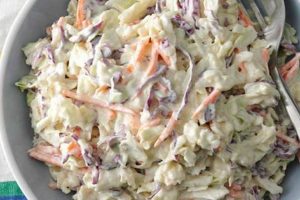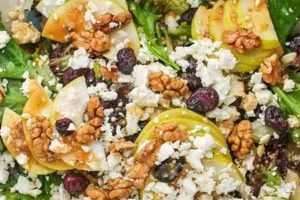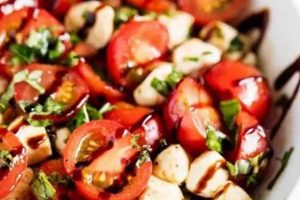A pineapple ring, half a banana, and a maraschino cherry arranged on a bed of lettuce create a visually striking dish reminiscent of a lit candle. Variations may include cottage cheese or cream cheese within the pineapple ring and a mayonnaise-based dressing. This presentation was particularly popular in the mid-20th century, often appearing in community cookbooks and home economics classes.
This dish offers a simple, yet visually appealing, way to serve fruit. Its popularity during a specific historical period reveals insights into culinary trends and aesthetic preferences of the time. The ease of preparation and accessibility of ingredients made it a practical choice for home cooks. While its popularity has waned in recent decades, it remains a nostalgic reminder of simpler times and provides an interesting case study in food history and presentation.
The following sections will delve further into the historical context of this unique dish, explore variations and modern interpretations, and discuss its place within the broader evolution of American cuisine.
Tips for Creating a Visually Appealing Fruit Presentation
Achieving the desired aesthetic requires attention to detail and careful ingredient selection. The following tips offer guidance for constructing an attractive and palatable fruit arrangement.
Tip 1: Selecting Ripe, but Firm Fruit: Overripe fruit will not hold its shape, compromising the structural integrity of the presentation. Choose fruit that is ripe but firm to the touch.
Tip 2: Proper Pineapple Preparation: Canned pineapple rings are the standard choice. Drain thoroughly to prevent excess liquid from accumulating on the plate. Fresh pineapple can be used, but requires careful slicing to achieve uniform rings.
Tip 3: Banana Browning Prevention: To prevent browning, the banana can be dipped in a solution of lemon juice and water. This will preserve its fresh appearance.
Tip 4: Strategic Cherry Placement: The maraschino cherry serves as the “flame” of the candle. Ensure it is securely positioned atop the banana “candle.” A toothpick can be used discreetly for stability.
Tip 5: Crisp Lettuce Selection: Choose crisp, fresh lettuce for the base. Iceberg or romaine lettuce provides a suitable foundation. Avoid wilted or discolored leaves.
Tip 6: Enhancing Visual Appeal: While traditional versions often incorporate mayonnaise, consider alternatives such as a dollop of Greek yogurt or a light dusting of powdered sugar for a more contemporary presentation.
Tip 7: Proportion and Balance: Maintain a balanced composition. The pineapple ring should provide a stable base for the banana and cherry. Avoid overcrowding the plate.
By following these tips, one can create a visually appealing and enjoyable fruit presentation that harkens back to a classic era while incorporating modern sensibilities.
This exploration of tips and techniques provides a foundation for understanding the preparation and presentation of this nostalgic dish. The concluding section will offer final thoughts and considerations.
1. Pineapple Ring Base
The pineapple ring serves as the foundation of the candle salad, providing both structural integrity and a sweet-tart flavor contrast. Its circular shape creates a stable base for the banana and cherry components, preventing them from tipping over. The pineapple’s inherent sweetness complements the other fruits while its slight acidity balances the overall flavor profile. This foundational element distinguishes the dish from a simple fruit platter, elevating it to a more structured presentation. For example, imagine attempting to balance a banana and cherry on a single lettuce leaf; the pineapple ring’s solid form is crucial. This base also contributes to the visual appeal, offering a bright, golden platform that contrasts with the other ingredients.
Historically, the use of canned pineapple rings reflects the convenience-focused culinary trends of the mid-20th century. Canned pineapple was readily available and required no preparation beyond draining, making it a practical choice for home cooks. This choice contributed to the widespread adoption and popularity of the candle salad during this era. Furthermore, the uniform shape and size of canned pineapple rings ensured consistency in presentation, an aspect valued in both home and institutional cooking. One can imagine the challenges of achieving consistent results using fresh pineapple given the variability in size and shape.
In conclusion, the pineapple ring base is integral to the candle salad, contributing to its structure, flavor, and historical context. Understanding its role provides insight into the dish’s construction, appeal, and place within culinary history. While seemingly a simple element, the pineapple ring plays a pivotal role in the overall success and recognizability of this nostalgic dish. This highlights the importance of seemingly minor components in shaping culinary traditions.
2. Banana Candle
The banana candle constitutes the central visual element of the candle salad recipe, directly contributing to the dish’s namesake and overall aesthetic. Its elongated shape and pale yellow color evoke the visual impression of a wax candle, particularly when juxtaposed with the pineapple ring base and the maraschino cherry “flame.” This resemblance is crucial for the dish’s symbolic representation of a lit candle, which distinguishes it from a typical fruit salad. Without the banana, the remaining components lack the necessary visual cues to evoke the intended imagery. Consider a plate with only lettuce, pineapple, and a cherry; the “candle” element is lost without the banana’s presence.
The banana’s relatively soft texture allows for easy insertion of the cherry, securing its position as the “flame.” This practicality reinforces the banana’s structural role within the dish. Furthermore, the banana’s subtle sweetness contributes to the overall flavor profile, complementing the pineapple’s tartness and the cherry’s sweetness. The banana’s mild flavor also prevents it from overpowering the other components, ensuring a balanced taste experience. For instance, substituting a stronger-flavored fruit like a kiwi would disrupt the delicate balance and detract from the intended candle-like presentation.
In summary, the banana candle’s significance within the candle salad recipe stems from its visual resemblance to a candle, its structural contribution to the dish, and its subtle yet complementary flavor. Its presence is essential for the dish’s symbolic representation and overall aesthetic coherence. Removing or substituting this key element compromises the dish’s defining characteristics, highlighting the banana candle’s crucial role in this nostalgic culinary creation. Understanding the interplay between these individual components offers valuable insight into the construction and historical context of the candle salad recipe as a whole. This analysis underscores the importance of each element in contributing to the dish’s overall impact.
3. Maraschino cherry flame
The maraschino cherry, perched atop the banana “candle,” functions as the “flame” in the candle salad recipe, completing the dish’s visual metaphor. This bright red, candied cherry provides a crucial pop of color against the paler hues of the banana and pineapple, drawing the eye and solidifying the illusion of a lit candle. The cherry’s small size and spherical shape further enhance this illusion, mimicking the flickering tip of a flame. Without the cherry, the “candle” remains incomplete, lacking the essential visual cue that ties the entire presentation together. Imagine a birthday cake without candles; the celebratory element is diminished. Similarly, the cherry’s absence fundamentally alters the candle salad’s intended representation.
The maraschino cherry’s intense sweetness contributes a distinct flavor note that complements the other fruit components. Its sugary syrup also adds a subtle glaze to the banana, enhancing its visual appeal and providing an additional layer of textural complexity. This interplay of flavors and textures demonstrates the cherry’s contribution beyond mere visual representation. For instance, substituting a fresh cherry, while visually similar, would lack the same intense sweetness and glossy texture, impacting both the flavor and the overall aesthetic. The distinctive flavor profile of the maraschino cherry, derived from its unique processing and brining, adds a specific nostalgic element that connects to the mid-20th century origins of the dish.
In conclusion, the maraschino cherry “flame” is not merely a decorative element but an integral component of the candle salad recipe, contributing to its visual identity, flavor profile, and historical context. Its vibrant color, distinct sweetness, and symbolic representation as a flame solidify its crucial role in completing the dish’s overall presentation. Understanding the cherry’s contribution provides a deeper appreciation for the careful construction and historical significance of this seemingly simple, yet symbolically rich, dish. This analysis emphasizes the importance of considering each ingredient’s contribution beyond its individual characteristics, highlighting the synergistic effect of the components within the overall composition.
4. Lettuce bed
The lettuce bed, while seemingly a minor component, plays a crucial role in the presentation and overall aesthetic of the candle salad recipe. It provides a foundation, both literally and visually, for the assembled fruit components, enhancing their appearance and contributing to the dish’s thematic coherence.
- Visual Contrast and Enhancement:
The lettuce’s vibrant green color contrasts with the other ingredients, creating a visually appealing backdrop that accentuates the colors of the pineapple, banana, and cherry. This contrast makes the “candle” elements stand out, enhancing their visual impact. The lettuce’s texture also provides a visual counterpoint to the smoother textures of the fruit, adding depth and complexity to the overall presentation. For instance, imagine placing the pineapple ring directly on a white plate; the visual impact is lessened without the green backdrop provided by the lettuce.
- Foundation and Stability:
The lettuce bed offers a slightly cushioned surface that helps to stabilize the pineapple ring, preventing it from sliding on the plate. This subtle, yet important, function contributes to the overall structural integrity of the “candle” arrangement. The lettuce also helps to absorb any excess moisture from the pineapple, keeping the presentation neat and preventing the other ingredients from becoming soggy. This practical function is essential for maintaining the dish’s intended appearance and preventing the components from sliding around.
- Symbolic Representation of Freshness:
The lettuce bed contributes to the overall impression of freshness and naturalness, aligning with broader culinary trends of incorporating fresh produce. This association with freshness enhances the perceived appeal of the dish, particularly within the context of its historical emergence during a time of increasing emphasis on healthy eating habits. The lettuce’s crispness further reinforces this impression of freshness, adding a textural element that complements the other ingredients. Consider the contrast between fresh, crisp lettuce and wilted, discolored leaves; the former contributes significantly to the dish’s overall appeal.
- Culinary Context and Historical Significance:
The use of lettuce as a base for the candle salad aligns with mid-20th-century culinary practices, which often featured salads as a component of meals. This inclusion of a “salad” element, even in a dish primarily composed of fruit, reflects broader culinary trends of the time. Furthermore, the lettuce bed contributes to the overall presentation of the dish, elevating it beyond a simple arrangement of fruit on a plate. This attention to presentation aligns with the emphasis on aesthetic appeal that characterized mid-century cuisine. This historical context provides insight into the dish’s construction and its place within broader culinary traditions.
In summary, the lettuce bed in the candle salad recipe contributes significantly to the dish’s visual appeal, structural integrity, symbolic representation, and historical context. While often overlooked, this seemingly simple element plays a crucial role in shaping the overall impression and experience of this nostalgic dish. Understanding the multifaceted contribution of the lettuce bed provides a deeper appreciation for the careful construction and historical significance of the candle salad recipe as a whole. This analysis reinforces the idea that even seemingly minor components contribute meaningfully to a dish’s overall impact and cultural significance.
5. Mayonnaise or Cottage Cheese
Mayonnaise or cottage cheese, while optional, represent a significant point of variation within the candle salad recipe, influencing both its flavor profile and its historical context. These additions, nestled within the pineapple ring, introduce a creamy, rich element that contrasts with the sweetness of the fruit and the crispness of the lettuce. Mayonnaise provides a tangy, savory note, while cottage cheese offers a milder, slightly acidic flavor and a distinct textural contrast. This element of choice allows for customization based on individual preferences, highlighting the adaptability of the recipe. Period cookbooks and community recipe collections often feature both versions, suggesting regional or personal preferences influenced ingredient selection. For example, a 1950s cookbook from the Midwestern United States might include mayonnaise as the standard, reflecting the prevalence of mayonnaise-based salads in the region, while a cookbook from the same era originating in the Northeast might favor cottage cheese, aligning with regional dairy traditions.
The inclusion of mayonnaise or cottage cheese reflects broader culinary trends of the mid-20th century, particularly the increasing popularity of convenience foods and the incorporation of creamy dressings and sauces into salads. Mayonnaise, a commercially produced condiment, offered convenience, while cottage cheese provided a readily available source of protein. These choices reflect the practical considerations of home cooks during this period, emphasizing efficiency and affordability. Furthermore, the addition of these creamy elements contributed to the perceived richness and satiety of the dish, aligning with cultural preferences for hearty meals. The choice between mayonnaise and cottage cheese can also be viewed through the lens of evolving dietary concerns. Cottage cheese, perceived as a healthier alternative, might have been favored by those seeking to reduce fat intake, even within the context of a dessert-like salad. This adaptability demonstrates the candle salad’s capacity to accommodate evolving dietary preferences.
In summary, the inclusion of mayonnaise or cottage cheese in the candle salad recipe contributes to its flavor complexity, reflects historical culinary trends and regional variations, and demonstrates the dish’s adaptability to individual preferences and evolving dietary concerns. Understanding the role of these optional ingredients provides valuable insight into the dish’s historical context and its continued relevance as a nostalgic culinary creation. This analysis underscores the significance of seemingly minor variations in shaping culinary traditions and reflecting broader cultural shifts in food preferences and consumption patterns. Further research exploring regional variations and the evolution of these ingredient choices could provide a deeper understanding of the candle salad’s enduring appeal and its place within the broader narrative of American culinary history.
6. Mid-century popularity
The candle salad recipe achieved peak popularity during the mid-20th century, specifically the 1950s and 1960s, reflecting the culinary trends and social dynamics of the era. Several factors contributed to its widespread adoption within American households. Post-World War II prosperity led to increased access to ingredients like canned pineapple and maraschino cherries, which were previously considered luxuries. The rise of suburban culture and an emphasis on home entertaining created a demand for easy-to-prepare, visually appealing dishes suitable for casual gatherings. The candle salad, with its simple assembly and festive presentation, fit this need perfectly. Community cookbooks and women’s magazines frequently featured the recipe, further solidifying its presence in the American culinary landscape. Examples include widely circulated publications like “Better Homes and Gardens” and local church or social club recipe collections, which served as primary sources of culinary inspiration for home cooks. These publications often emphasized the dish’s visual appeal and ease of preparation, appealing to busy homemakers seeking efficient yet impressive recipes.
The candle salad’s popularity also aligns with the aesthetic sensibilities of the mid-century period. The emphasis on bright colors, playful presentations, and kitsch aesthetics found expression in various aspects of American culture, from fashion and home decor to food. The candle salad, with its vibrant colors and whimsical candle-like presentation, exemplified this trend. Furthermore, the dish’s reliance on readily available, often processed, ingredients reflects the growing acceptance of convenience foods in post-war America. This practicality further contributed to the recipe’s broad appeal, making it accessible to a wide range of households. The candle salad’s presence at potlucks, church suppers, and family gatherings solidified its role as a social and culinary marker of the era. Photographs and anecdotal accounts from family gatherings during this period often feature the candle salad, providing tangible evidence of its widespread presence.
Understanding the mid-century popularity of the candle salad recipe provides valuable insights into the culinary and social landscape of post-war America. Its prevalence reflects the convergence of economic prosperity, evolving culinary trends, and changing social dynamics. The dish’s enduring presence in cultural memory, often tinged with nostalgia, highlights its significance as a culinary artifact of a specific historical moment. Further research exploring regional variations and the eventual decline in the candle salad’s popularity could offer deeper understanding of evolving culinary tastes and shifting cultural values surrounding food and presentation. Analyzing the factors that contributed to the candle salad’s rise and fall offers a unique lens through which to examine broader trends in American culinary history.
7. Nostalgic Presentation
The candle salad recipe’s nostalgic presentation evokes a specific era in American culinary history, primarily the mid-20th century. This strong association with a bygone era contributes significantly to the dish’s enduring cultural relevance, despite its decline in contemporary cuisine. Analyzing the elements contributing to this nostalgic appeal offers valuable insights into evolving culinary trends, aesthetic preferences, and the role of food in shaping collective memory.
- Visual Representation of Simplicity:
The candle salad’s straightforward presentation embodies a simpler time in food preparation, contrasting with the complexity and elaborate plating often associated with modern cuisine. Its reliance on readily available ingredients and minimal preparation techniques reflects a practical approach to cooking that resonates with memories of family meals and unpretentious gatherings. The dish’s visual simplicity evokes a sense of comfort and familiarity, reminiscent of home-cooked meals and a less demanding culinary landscape. This contrasts sharply with contemporary food culture’s emphasis on intricate techniques and visually complex plating.
- Symbolic Resonance with Festive Occasions:
The candle-like presentation of the salad often connects with memories of celebratory occasions, such as birthdays, holidays, and community potlucks. The resemblance to a lit candle evokes a sense of festivity and special occasions, reinforcing the dish’s association with positive memories and shared experiences. This symbolic resonance contributes to the emotional impact of the dish, triggering nostalgic associations with past celebrations and communal gatherings. The candle salad’s presence at these events further cemented its place in cultural memory as a symbol of shared experiences and celebratory traditions.
- Connection to Retro Aesthetics:
The candle salad’s visual style aligns with the broader aesthetic trends of the mid-20th century, characterized by bright colors, playful presentations, and a touch of kitsch. This visual connection to a specific historical period further enhances the dish’s nostalgic appeal, triggering broader cultural memories beyond the realm of food. The use of canned pineapple rings, maraschino cherries, and mayonnaise-based dressings reinforces this connection to mid-century culinary practices, contributing to the dish’s retro charm. This aesthetic appeal extends beyond the dish itself, encompassing the broader cultural context in which it originated.
- Intergenerational Transmission of Culinary Traditions:
The candle salad recipe often serves as a conduit for intergenerational connections, passed down through family traditions and community cookbooks. This transmission of culinary knowledge reinforces the dish’s nostalgic significance, linking it to personal histories and shared family memories. The act of preparing and consuming the candle salad can evoke memories of past generations and reinforce family bonds, contributing to the dish’s emotional resonance. This intergenerational connection distinguishes the candle salad from trendy dishes, anchoring it within a broader familial and cultural narrative. This transmission of culinary knowledge contributes to the preservation of cultural heritage and the perpetuation of family traditions.
In conclusion, the nostalgic presentation of the candle salad recipe plays a crucial role in its enduring cultural relevance. The dish’s visual simplicity, symbolic resonance, connection to retro aesthetics, and role in intergenerational transmission of culinary traditions contribute to its nostalgic appeal. By analyzing these elements, we gain a deeper understanding of the complex interplay between food, memory, and cultural identity. This exploration highlights the significance of seemingly simple dishes in shaping collective memory and reflecting broader cultural trends. The candle salad, though a seemingly humble dish, offers a valuable lens through which to examine the evolving relationship between food, nostalgia, and cultural identity.
Frequently Asked Questions
This section addresses common inquiries regarding the candle salad recipe, providing factual information and clarifying potential misconceptions.
Question 1: Is the candle salad intended as a dessert or a salad?
Its categorization varies depending on cultural context and individual interpretation. The sweetness of the fruit suggests a dessert classification, while the inclusion of lettuce and sometimes mayonnaise aligns with salad conventions. Historically, it often appeared as part of a larger meal, blurring the lines between salad and dessert courses.
Question 2: Are there variations on the traditional recipe?
Variations exist, primarily concerning the creamy element. Cottage cheese, cream cheese, or yogurt can substitute for mayonnaise. Some recipes incorporate nuts or other fruits, while others omit the lettuce entirely. These variations reflect regional preferences and individual adaptations.
Question 3: Why is the candle salad associated with the mid-20th century?
Its popularity during this period stems from the increased availability of canned pineapple and maraschino cherries, coupled with the rise of suburban culture and an emphasis on easy-to-prepare, visually appealing dishes for entertaining.
Question 4: Is the candle salad still popular today?
While less common than in its mid-century heyday, the candle salad persists as a nostalgic dish, often appearing at retro-themed parties or family gatherings with a historical connection to the recipe.
Question 5: What accounts for the nostalgic appeal of the candle salad?
Its nostalgic appeal derives from its association with simpler times, family traditions, and the distinctive aesthetic sensibilities of the mid-20th century. It serves as a culinary reminder of past eras and cultural practices.
Question 6: How does the candle salad reflect broader culinary trends?
The candle salad reflects evolving trends in food presentation, ingredient availability, and cultural preferences. Its historical trajectory offers insights into changing culinary practices and evolving tastes within American cuisine.
Understanding the historical context and variations associated with the candle salad recipe provides a richer appreciation for its unique place within American culinary history.
Further exploration of related recipes and culinary traditions of the mid-20th century can enhance understanding of the broader cultural landscape surrounding this nostalgic dish.
Candle Salad Recipe
This exploration of the candle salad recipe has illuminated its historical context, construction, and enduring cultural significance. From the pineapple ring base to the maraschino cherry flame, each component contributes to the dish’s unique identity. Its mid-century popularity reflects broader culinary and social trends, while its nostalgic presentation evokes a sense of bygone eras and family traditions. The variations observed within the recipe, particularly regarding the use of mayonnaise or cottage cheese, demonstrate its adaptability and regional influences.
The candle salad recipe serves as a tangible link to past culinary practices, offering a glimpse into the evolving tastes and aesthetic preferences of American cuisine. Further investigation into related recipes and culinary traditions of the mid-20th century can deepen understanding of the broader cultural landscape surrounding this nostalgic dish. Its continued presence, albeit often in a retrospective context, underscores the power of food to evoke memories, connect generations, and preserve cultural heritage. The candle salad recipe, though seemingly simple, offers a rich and rewarding area of study for culinary historians and anyone interested in the intersection of food, culture, and memory.






